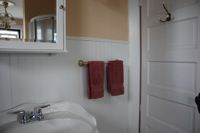DIY Tips for Interior Painting
by: Dale Cox

Before beginning to paint a room it would be a good idea to first consider the type of paint you will be using. It will make the job easier all around if you use flat latex paint on the ceiling and walls. This will make it possible to touch up paint on missed spots and smudges, without flashing. It will also make it easier to cut in and if you need to mask to paint a straight line, painting with flat latex makes for sharper lines and less peeling when removing the tape.
If You're Using Flat Paint
Using flat latex will also reduce the amount of work required because it will be self-priming on all wall repairs. Using just one paint means no need for two rollers and no need to wait til primer dries before starting to roll the ceiling or walls. The flat paint can also be used to prime any joint compound or spackling paste on wood trim.
If You're Using Shiny Paint
If you need to use a shiny paint like eggshell, semi-gloss or high-gloss on the walls or ceiling, you will need to take extra care to avoid flashing and roller marks. It won't be possible to touch up in most cases without causing a flashing problem and it's not possible at all when the paint has dried, even slightly.
All joint compound will have to be thoroughly primed with a flat paint or there will be dull spots in the finish. Rolling shiny paint will also require special attention to the direction you roll to avoid an uneven finish. Always roll in the same direction and overlap your strokes repeatedly to blend the paint evenly. This will make it harder to do a good job on ceilings when furniture is stacked and covered in the center of the room and you have to work around it.
Use a Quality Paint
Another consideration with regard to paint choice is the quality. Always use the best, usually most expensive, paint a supplier offers. Top quality paints are thicker and will cover much better than even the second best paint in a product line. Better quality translates to better coverage and can be the difference between one or two coats, and multiple coats to cover completely. While top quality paint will be a bit more expensive than the lower grades the saved labor will more than make up for the cost.
Setting Up to Paint a Room
Painting a room should be done in a logical order to minimize the work and cleanup required to complete the job. The first step is to take everything off the walls, ceiling, and trim and move all the furniture into the center of the room.
If you will be painting the ceiling, you will want to either provide a space for a ladder under any center light fixture or plan to paint around the fixture before moving anything under it. Then you can roll the ceiling with a roller pole after everything is covered in the middle of the room.
This will only really work if you're using flat latex paint on the ceiling. If you're using eggshell or other shiny paint it will probably cause a flashing problem if you wait too long to roll into the brush work. In these cases, try to brush around the fixture just before rolling the paint on the ceiling.
Remove Furniture or Not?
If you want to use a shiny ceiling paint or you have a lot of repairs and other work to do on the ceiling, you may want to move all furniture out of the room. The work involved will be well worth it in saved effort on the ceiling painting and repairs. It will also make the whole paint job much easier and keep dust off all your stuff.
If you choose to work with the furniture in the room, use one or two large drop cloths to cover everything in the center and then cover the floors around the perimeter with runners (long narrow drop cloths). A thin, 1-mil plastic can be used to cover furniture in the center but canvas drop cloths should be used on the floor. The canvas will be easier to shake to remove scraping and sanding dust before beginning with the painting part of the job, and they won't slip around when walking on them.

Painting a Bathroom
Bathrooms can be a problem if moisture constantly forms on the walls from hot showers, etc. If this is the case and the existing paint is peeling or mildew has formed, these issues should be resolved before any paint is applied. Kill mildew with a 25% bleach water solution using the process, Killing Mildew Before Painting.
Peeling paint on bathroom walls is usually caused by moisture between the paint coat and the wall surface. To repair this damage scrape off all loose, peeling paint and wall material, seal the surface, and repair the damage.
Choosing Bathroom Paint
When the walls are ready, prime any repair compound with flat latex paint or latex primer and let it dry completely before applying alkyd-based, or shiny finish paint like semi-gloss latex. In bathrooms with a chronic moisture problem, where previous wall damage has occurred, use alkyd-based finish paint to help block future moisture penetration. In bathrooms with recurring mildew, use an acrylic latex paint with a mildew retardant added or mix an additive into your paint yourself.
In bathrooms that don't have an existing moisture problem it's best to use latex paint on drywall and plaster walls and ceilings. Contrary to popular belief, latex paint does not peel when exposed to moisture. Latex actually breathes much better than alkyd or oil paints, particularly flat latex. This breathing allows water vapor to move through the paint coat and wall material, preventing trapped moisture from causing a peeling problem.
Painting Wall Paneling
Wipe simulated wood paneling with denatured alcohol and prime with a shellac-based primer-sealer before finish coating with latex or alkyd wall paint. Real wood paneling should be lightly sanded with medium grit sandpaper and primed with an alkyd undercoat. Finish coat with latex or alkyd wall paint. When coating large surfaces like walls with shellac primer or alkyd paints, wear a painter's respirator and ventilate the room to avoid breathing the fumes.
Painting Over Wallpaper
Prime wallpaper before applying any finish paint. Check to see what type of wallpaper you're dealing with, vinyl or paper wallpaper. See Wallpaper Removal for help. Vinyl wallpaper should be primed with a sellac-based primer-sealer. This will help to ensure that the finish paint coat will bond well with the wallpaper. Use interior latex or alkyd wall paint for finish coating.
Paper wallpaper will have to be primed with two coats of alkyd or shellac-based primer to ensure latex paint will not penetrate and cause it to bubble or pucker. If you're using alkyd-based finish paint it will be self-priming. Just apply two coats to ensure good coverage. Also, wear a respirator when using this on large areas.
Painting Over Milk Paint
Milk paint, also called casein paint, is sometimes found in older houses on walls or as a finish on antique furniture. As the name implies this paint was made using milk as the vehicle. It has a hard finish and is impervious to paint strippers. You can spot casein paint by its very smooth finish and dull brown or pale, pastel colors including: yellow, pink, blue, and green.
If you have milk paint on your walls it will probably be a problem to paint or decorate with wallpaper because it doesn't hold a conventional paint finish well. Before you repaint over milk paint use a primer-sealer to seal it and you will greatly improve your chances of success. If you already have a problem with peeling paint over milk paint, scrape off all the loose paint and prime with primer-sealer before doing repairs. Provide plenty of ventilation and wear a painter's respirator when using it inside on large surfaces.